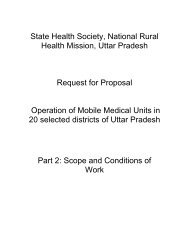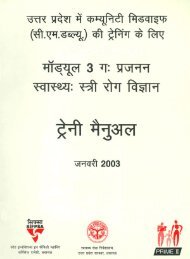Obstetrics Manual for Merrygold Hospitals - State Innovations in ...
Obstetrics Manual for Merrygold Hospitals - State Innovations in ...
Obstetrics Manual for Merrygold Hospitals - State Innovations in ...
Create successful ePaper yourself
Turn your PDF publications into a flip-book with our unique Google optimized e-Paper software.
• Anti – emetic Drugs-oral doxylam<strong>in</strong>e succ<strong>in</strong>ate and B6; Promethaz<strong>in</strong>e(<br />
Phenargan) 25mg or Prochlorperaz<strong>in</strong>e (Stemetil) 5 mg. In patients not respond<strong>in</strong>g<br />
to above treatment, give Inj Ondensetreon 8mg I/V 12 hrly.<br />
• Advise the woman to take small, frequent, carbohydrate rich meals.<br />
• Sympathetic but the firm handl<strong>in</strong>g of the patient is essential.<br />
• Once the vomit<strong>in</strong>g stops and the dehydration is corrected, discharge after 24<br />
hours.<br />
Case Study – Hyperemesis Gravidarum<br />
A 35 year old married shop assistant was referred as an emergency <strong>for</strong> antenatal<br />
assessment because of <strong>in</strong>tractable vomit<strong>in</strong>g. Marked nausea and sickness had complicated<br />
her first pregnancy, a breech delivery, and she was not there<strong>for</strong>e surprised when this<br />
persisted. Her second pregnancy had however been entirely normal.<br />
The vomit<strong>in</strong>g <strong>in</strong>itially occurred <strong>in</strong> the morn<strong>in</strong>g, but as the pregnancy progressed it<br />
occurred throughout the day and became progressively more severe. Dur<strong>in</strong>g the 48 hours<br />
prior to her admission, she had been unable to reta<strong>in</strong> even clear liquids and had sought<br />
the help of her family doctor. He had been concerned at her general condition and the fact<br />
that her uterus appeared to be at least 4 weeks larger than the duration of her pregnancy,<br />
calculat<strong>in</strong>g from the date of her last pill withdrawal bleed. She had not experienced any<br />
other vag<strong>in</strong>al bleed or any pa<strong>in</strong> s<strong>in</strong>ce this time. There had been no change <strong>in</strong> her bowel<br />
habits and she had no ur<strong>in</strong>ary symptoms. Apart from an appendectomy at the age of 21<br />
years her past history was unremarkable. There was no relevant family history.<br />
On exam<strong>in</strong><strong>in</strong>g she was clearly dehydrated and distressed by her constant nausea and<br />
persistent vomit<strong>in</strong>g. Her temperature was 36.8 C, pulse rate 104 beats / m<strong>in</strong>ute and blood<br />
pressure 100/60 mm Hg, she did not appear anaemic and there was no abnormality on<br />
general exam<strong>in</strong>ation. Her breasts were normal. Abdom<strong>in</strong>al palpitation revealed a 16-week<br />
uterus, which was regular <strong>in</strong> outcome. There was no other suggestion of abdom<strong>in</strong>al<br />
distension and her abdomen was non tender with normal bowel sounds. Vag<strong>in</strong>al<br />
exam<strong>in</strong>ation was normal and bimanual palpation confirmed the uterus size. A pregnancy<br />
test was strongly positive.<br />
Questions<br />
1. What is the differential diagnosis?<br />
2. What <strong>in</strong>vestigation would you per<strong>for</strong>m?<br />
3. What are the complications of this condition?<br />
4. Name a well-known authoress who died of this condition.<br />
24










